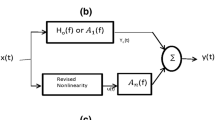Abstract
Dynamic autoregulation of cerebral hemodynamics in healthy humans is studied using the novel methodology of the Laguerre–Volterra network for systems with fast and slow dynamics (Mitsis, G. D., and V. Z. Marmarelis, Ann. Biomed. Eng. 30:272–281, 2002). Since cerebral autoregulation is mediated by various physiological mechanisms with significantly different time constants, it is used to demonstrate the efficacy of the new method. Results are presented in the time and frequency domains and reveal that cerebral autoregulation is a nonlinear and dynamic (frequency-dependent) system with considerable nonstationarities. Quantification of the latter reveals greater variability in specific frequency bands for each subject in the low and middle frequency range (below 0.1 Hz). The nonlinear dynamics are prominent also in the low and middle frequency ranges, where the frequency response of the system exhibits reduced gain. © 2002 Biomedical Engineering Society.
PAC2002: 8719Uv, 8719La, 8710+e
Similar content being viewed by others
REFERENCES
Aaslid, R. K., W. Lindengaard, W. Sorterberg, and H. Nornes. Cerebral autoregulation dynamics in humans. Stroke 20:45–52, 1989.
Chon, K. H., Y. M. Chen, N. H. Holstein-Rathlou, and V. Z. Marmarelis. Nonlinear system analysis of renal autoregulation in normotensive and hypertensive rats. IEEE Trans. Biomed. Eng. 45:342–353, 1998.
Chon, K. H., Y. M. Chen, V. Z. Marmarelis, D. J. Marsh, and N. H. Holstein-Rathlou. Detection of interactions between myogenic and TGF mechanisms using nonlinear analysis. Am. J. Physiol. 267:F160–F173, 1994.
Diehl, R. R., D. Linden, D. Lucke, and P. Berlit. Phase relationship between cerebral blood flow velocity and blood pressure. A clinical test of autoregulation. Stroke 26:1801–1804, 1995.
Faraci, F. M., and D. D. Heistad. Regulation of the cerebral circulation: Role of endothelium and potassium channels. Physiol. Rev. 78:53–97, 1998.
Giller, C. A. The frequency-dependent behavior of cerebral autoregulation. Neurosurgery 27:362–368, 1990.
Heistad, D. D., and H. A. Kontos. Cerebral circulation. In: Handbook of Physiology. The Cardiovascular System. Peripheral Circulation and Organ Blood Flow. Bethesda, MD: Am. Physiol. Soc., 1983, Sec. 2, Vol. III, Part 1, Chap. 5, pp. 137–182.
Kuo, T. B. J., C. M. Chern, W. Y. Sheng, W. J. Wong, and H. H. Hu. Frequency domain analysis of cerebral blood flow velocity and its correlation with arterial blood pressure. J. Cereb. Blood Flow Metab. 18:311–318, 1998.
Lee, Y. W. and M. Schetzen. Measurement of the Wiener kernels of a nonlinear system by cross-correlation. Int. J. Control 2:237–254, 1965.
Marmarelis, V. Z. Identification of nonlinear biological systems using Laguerre expansions of kernels. Ann. Biomed. Eng. 21:573–589, 1993.
Marsh, D. J., J. L. Osborn, and W. J. Cowley. 1/f fluctuations in arterial pressure and regulation of renal blood flow in dogs. Am. J. Physiol. 258:F1394–F1400, 1990.
Mitsis, G. D., and V. Z. Marmarelis. Modeling of nonlinear systems with fast and slow dynamics. Methodology. Ann. Biomed. Eng. 30:272–281, 2002.
Panerai, R. B., A. W. R. Kelsall, J. M. Rennie, and D. H. Evans. Frequency-domain analysis of cerebral autoregulation from spontaneous fluctuations in arterial blood pressure. Med. Biol. Eng. Comput. 36:315–322, 1998.
Panerai, R. B., D. M. Simpson, S. T. Deverson, P. Mahony, P. Hayes, and D. H. Evans.Multivariate dynamic analysis of cerebral blood flow regulation in humans. IEEE Trans. Biomed. Eng. 47:419–423, 2000.
Panerai, R. B., S. L. Dawson, and J. F. Potter. Linear and nonlinear analysis of human dynamic cerebral autoregulation. Am. J. Physiol. 277:H1089–H1099, 1999.
Paulson, O. B., B. Strandgaard, and L. Edvinsson. Cerebral autoregulation. Cerebrovasc. Brain Metab. Rev. 2:161–192, 1990.
Rissanen, J. Information Theory and Neural Nets. In: Mathematical Perspectives on Neural Networks, edited by P. Smolensky, M. C. Mozer, and D. E. Rumelhart. Mahwah, NJ: Lawrence Erlbaum Associates, 1996, pp. 567–602.
Tiecks, F. P., A. M. Lam, B. F. Matta, S. Strebel, C. Douville, and D. W. Newell. Effects of the Valsalva maneuver on cerebral circulation in healthy adults. A transcranial Doppler study. Stroke 26:1386–1392, 1995.
Tiecks, F. P., A. M. Lam, R. Aaslid, and D. W. Newell. Comparison of static and dynamic cerebral autoregulation measurements. Stroke 26:1014–1019, 1995.
Zhang, R., J. H. Zuckerman, and B. D. Levine. Spontaneous fluctuations in cerebral blood flow velocity: Insights from extended duration recordings in humans. Am. J. Physiol. 278:H1848–H1855, 2000.
Zhang, R., J. H. Zuckerman, C. A. Giller, and B. D. Levine. Transfer function analysis of dynamic cerebral autoregulation in humans. Am. J. Physiol. 274:H233–H241, 1998.
Author information
Authors and Affiliations
Rights and permissions
About this article
Cite this article
Mitsis, G.D., Zhang, R., Levine, B.D. et al. Modeling of Nonlinear Physiological Systems with Fast and Slow Dynamics. II. Application to Cerebral Autoregulation. Annals of Biomedical Engineering 30, 555–565 (2002). https://doi.org/10.1114/1.1477448
Issue Date:
DOI: https://doi.org/10.1114/1.1477448




